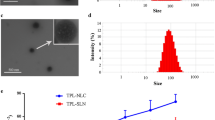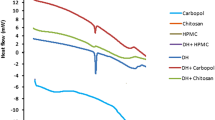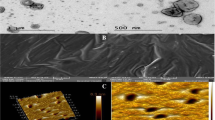ABSTRACT
Purpose
To evaluate the skin pharmacokinetics and tissue distribution of cell penetrating peptides (CPP) modified nano-structured lipid carrier (NLC) using an in vivo dermal microdialysis (MD) technique.
Methods
Celecoxib (Cxb) encapsulated NLCs (CXBN), CPP modified CXBN (CXBN-CPP) and Cxb-Solution (CXBS) formulations were prepared and tested for in vitro skin distribution. MD was used to assess pharmacokinetic parameters of Cxb after topical application of Cxb formulations. The effect of pre-treatment with Cxb formulations was evaluated for expression of prostaglandin-E2 (PGE2) and Interleukin-6 (IL-6) after exposure of xylene using MD. Allergic contact dermatitis (ACD) model was used to confirm in vivo therapeutic response of Cxb formulations.
Results
The cumulative permeation of Cxb in MD dialysate after 24 h for CXBN-CPP was significantly higher (p < 0.001) than CXBN and CXBS. Further, pre-treatment with CXBN-CPP significantly inhibited PGE2 and IL-6 expression compared to CXBS and CXBN (p < 0.001). In ACD model, CXBN-CPP showed significant reduction (p < 0.001) in ear thickness compared to controls.
Conclusions
Surface modification of NLC with CPPs can enhance the skin permeation of Cxb and MD can be used to investigate pharmacokinetics of Cxb nanoparticles in the skin.










Similar content being viewed by others
Abbreviations
- ACD:
-
allergic contact dermatitis
- CPP:
-
cell penetrating peptide
- Cxb:
-
Celecoxib
- CXBN:
-
Cxb encapsulated NLCs
- CXBN-R11 :
-
Polyarginine-11 (R11) coated CXBN
- CXBN-R15 :
-
Polyarginine-11 (R15) coated CXBN
- CXBN-R8 :
-
Polyarginine-8 (R8) coated CXBN
- CXBN-TAT:
-
TAT coated CXBN
- CXBN-YKA:
-
YKA coated CXBN
- CXBS:
-
Celecoxib-solution
- DOGS-NTA-Ni:
-
1,2-dioleoyl-sn-glycero-3-[(N-(5-amino-1-carboxypentyl) imidodiacetic acid) succinyl nickel salt]
- IL-6:
-
interleukin-6
- MD:
-
microdialysis
- NLC:
-
nano-structured lipid carrier
- PGE2 :
-
prostaglandin E2
- TAT:
-
trans-acting activator of transcription
REFERENCES
Jensen LB, Petersson K, Nielsen HM. In vitro penetration properties of solid lipid nanoparticles in intact and barrier-impaired skin. Eur J Pharm Biopharm. 2011;79:68–75.
Baroli B. Penetration of nanoparticles and nanomaterials in the skin: fiction or reality? J Pharm Sci. 2010;99:21–50.
Patlolla RR, Desai PR, Belay K, Singh MS. Translocation of cell penetrating peptide engrafted nanoparticles across skin layers. Biomaterials. 2010;31:5598–607.
Desai PR, Patlolla RR, Singh M. Interaction of nanoparticles and cell-penetrating peptides with skin for transdermal drug delivery. Mol Membr Biol. 2010;27:247–59.
Mitchell DJ, Kim DT, Steinman L, Fathman CG, Rothbard JB. Polyarginine enters cells more efficiently than other polycationic homopolymers. J Pept Res. 2000;56:318–25.
Futaki S, Nakase I, Suzuki T, Youjun Z, Sugiura Y. Translocation of branched-chain arginine peptides through cell membranes: flexibility in the spatial disposition of positive charges in membrane-permeable peptides. Biochemistry. 2002;41:7925–30.
Futaki S, Suzuki T, Ohashi W, Yagami T, Tanaka S, Ueda K, et al. Arginine-rich peptides. An abundant source of membrane-permeable peptides having potential as carriers for intracellular protein delivery. J Biol Chem. 2001;276:5836–40.
Mathy FX, Ntivunwa D, Verbeeck RK, Preat V. Fluconazole distribution in rat dermis following intravenous and topical application: a microdialysis study. J Pharm Sci. 2005;94:770–80.
Groth L, Serup J. Cutaneous microdialysis in man: effects of needle insertion trauma and anaesthesia on skin perfusion, erythema and skin thickness. Acta Derm Venereol. 1998;78:5–9.
Mathy FX, Denet AR, Vroman B, Clarys P, Barel A, Verbeeck RK, et al. In vivo tolerance assessment of skin after insertion of subcutaneous and cutaneous microdialysis probes in the rat. Skin Pharmacol Appl Skin Physiol. 2003;16:18–27.
Holmgaard R, Nielsen JB, Benfeldt E. Microdialysis sampling for investigations of bioavailability and bioequivalence of topically administered drugs: current state and future perspectives. Skin Pharmacol Physiol. 2010;23:225–43.
Benfeldt E, Hansen SH, Volund A, Menne T, Shah VP. Bioequivalence of topical formulations in humans: evaluation by dermal microdialysis sampling and the dermatopharmacokinetic method. J Invest Dermatol. 2007;127:170–8.
Stenken JA, Church MK, Gill CA, Clough GF. How minimally invasive is microdialysis sampling? A cautionary note for cytokine collection in human skin and other clinical studies. AAPS J. 2010;12:73–8.
Kreilgaard M. Assessment of cutaneous drug delivery using microdialysis. Adv Drug Deliv Rev. 2002;54:S99–S121.
Salgo R, Thaci D, Boehncke S, Diehl S, Hofmann M, Boehncke WH. Microdialysis documents changes in the micromilieu of psoriatic plaques under continuous systemic therapy. Exp Dermatol. 2011;20:130–3.
Shakeel F, Baboota S, Ahuja A, Ali J, Shafiq S. Skin permeation mechanism and bioavailability enhancement of celecoxib from transdermally applied nanoemulsion. J Nanobiotechnology. 2008;6:8.
Patlolla RR, Mallampati R, Fulzele SV, Babu RJ, Singh M. Dermal microdialysis of inflammatory markers induced by aliphatic hydrocarbons in rats. Toxicol Lett. 2009;185:168–74.
Fulzele SV, Babu RJ, Ahaghotu E, Singh M. Estimation of proinflammatory biomarkers of skin irritation by dermal microdialysis following exposure with irritant chemicals. Toxicology. 2007;237:77–88.
Souto EB, Wissing SA, Barbosa CM, Muller RH. Development of a controlled release formulation based on SLN and NLC for topical clotrimazole delivery. Int J Pharm. 2004;278:71–7.
Babu RJ, Kanikkannan N, Kikwai L, Ortega C, Andega S, Ball K, et al. The influence of various methods of cold storage of skin on the permeation of melatonin and nimesulide. J Control Release. 2003;86:49–57.
Kearney JN. Guidelines on processing and clinical use of skin allografts. Clin Dermatol. 2005;23:357–64.
Patlolla RR, Chougule M, Patel AR, Jackson T, Tata PN, Singh M. Formulation, characterization and pulmonary deposition of nebulized celecoxib encapsulated nanostructured lipid carriers. J Control Release. 2010;144:233–41.
Shah PP, Desai PR, Channer D, Singh M. Enhanced skin permeation using polyarginine modified nanostructured lipid carriers. J Control Release. 2012. doi:10.1016/j.jconrel.2012.05.011.
Shah P, Desai P, Patel A, Singh M. Skin permeating nanogel for the cutaneous co-delivery of two anti-inflammatory drugs. Biomaterials. 2012;33:1607–17.
Shah PP, Desai P, Singh M. Effect of oleic acid modified polymeric bilayered nanoparticles on percutaneous delivery of spantide II and ketoprofen. J Control Release. 2012;158:336–45.
Schafer-Korting M, Mehnert W, Korting HC. Lipid nanoparticles for improved topical application of drugs for skin diseases. Adv Drug Deliv Rev. 2007;59:427–43.
Prow TW, Grice JE, Lin LL, Faye R, Butler M, Becker W, et al. Nanoparticles and microparticles for skin drug delivery. Adv Drug Deliv Rev. 2011;63:470–91.
Fang JY, Fang CL, Liu CH, Su YH. Lipid nanoparticles as vehicles for topical psoralen delivery: Solid lipid nanoparticles (SLN) versus nanostructured lipid carriers (NLC). Eur J Pharm Biopharm. 2008;70:633–40.
Lopes LB, Furnish E, Komalavilas P, Seal BL, Panitch A, Bentley MV, et al. Enhanced skin penetration of P20 phosphopeptide using protein transduction domains. Eur J Pharm Biopharm. 2008;68:441–5.
Uchida T, Kanazawa T, Takashima Y, Okada H. Development of an efficient transdermal delivery system of small interfering RNA using functional peptides, Tat and AT-1002. Chem Pharm Bull(Tokyo). 2011;59:196–201.
Cohen-Avrahami M, Libster D, Aserin A, Garti N. Sodium diclofenac and cell-penetrating peptides embedded in H(II) mesophases: physical characterization and delivery. J Phys Chem B. 2011;115:10189–97.
Cohen-Avrahami M, Aserin A, Garti N. H(II) mesophase and peptide cell-penetrating enhancers for improved transdermal delivery of sodium diclofenac. Colloids Surf B Biointerfaces. 2010;77:131–8.
Shinkai N, Korenaga K, Takizawa H, Mizu H, Yamauchi H. Percutaneous penetration of felbinac after application of transdermal patches: relationship with pharmacological effects in rats. J Pharm Pharmacol. 2008;60:71–6.
Shinkai N, Korenaga K, Okumura Y, Mizu H, Yamauchi H. Microdialysis assessment of percutaneous penetration of ketoprofen after transdermal administration to hairless rats and domestic pigs. Eur J Pharm Biopharm. 2011;78:415–21.
Sjogren F, Anderson CD. Are cutaneous microdialysis cytokine findings supported by end point biopsy immunohistochemistry findings? AAPS J. 2010;12:741–9.
Yang BC, Chu ZF, Zhu S, Wang LJ, Feng YH, Li FH, et al. Study of pharmacokinetics and tissue distribution of liposomal brucine for dermal administration. Int J Nanomedicine. 2011;6:1109–16.
Eberle T, Doganci B, Kramer H, Fechir M, Wagner I, Sommer C, et al. Mechanical but not painful electrical stimuli trigger TNF alpha release in human skin. Exp Neurol. 2010;221:246–50.
Zhang F, Koyama Y, Sanuki R, Mitsui N, Suzuki N, Kimura A, et al. IL-17A stimulates the expression of inflammatory cytokines via celecoxib-blocked prostaglandin in MC3T3-E1 cells. Arch Oral Biol. 2010;55:679–88.
Davis TW, Zweifel BS, O’Neal JM, Heuvelman DM, Abegg AL, Hendrich TO, et al. Inhibition of cyclooxygenase-2 by celecoxib reverses tumor-induced wasting. J Pharmacol Exp Ther. 2004;308:929–34.
Hirano T. Interleukin-6 and its relation to inflammation and disease. Clin Immunol Immunopathol. 1992;62:S60–5.
ACKNOWLEDGMENTS AND DISCLOSURES
This project was supported by the National Center for Research Resources and the National Institute of Minority Health and Health Disparities of the National Institutes of Health through Grant Number 8 G12 MD007582-28 and 2 G12 RR003020. The authors declare no conflicts.
Author information
Authors and Affiliations
Corresponding author
Rights and permissions
About this article
Cite this article
Desai, P.R., Shah, P.P., Patlolla, R.R. et al. Dermal Microdialysis Technique to Evaluate the Trafficking of Surface-Modified Lipid Nanoparticles upon Topical Application. Pharm Res 29, 2587–2600 (2012). https://doi.org/10.1007/s11095-012-0789-2
Received:
Accepted:
Published:
Issue Date:
DOI: https://doi.org/10.1007/s11095-012-0789-2




